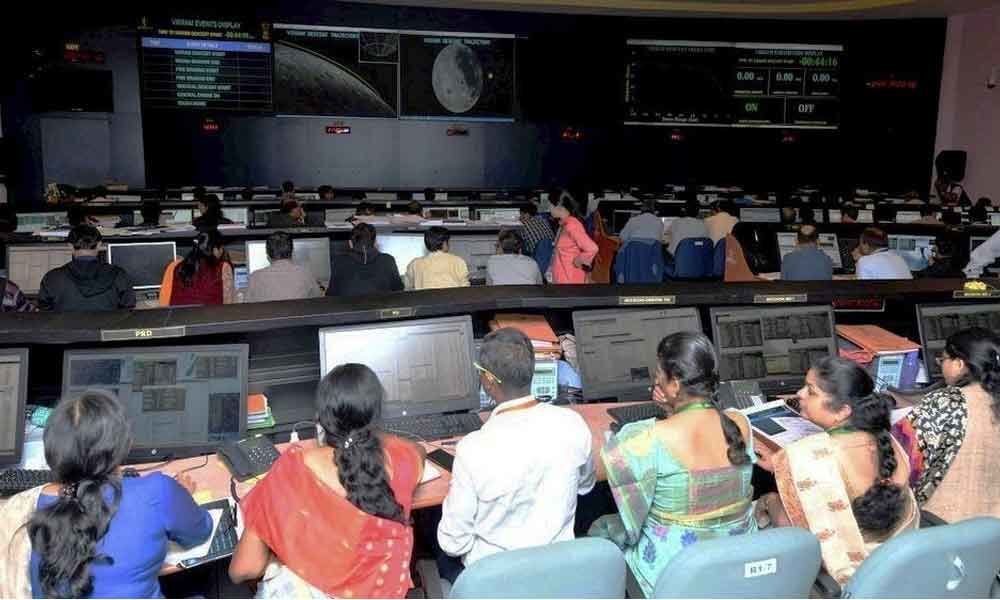Live
- BGT 2024-25: No greater honour to lead India in Test cricket, says Bumrah ahead of series opener
- NMO Bharat calls for apology from Rahul Gandhi over ageist remarks about Joe Biden
- Centre blocks 17,000 WhatsApp accounts of hackers from South-East Asia
- Learn from Mumbai hoarding collapse, Calcutta HC tells Bengal municipal corporation
- Russian Spokesperson Instructed to Stay Silent on ICBM Strike During Press Conference: Viral Video
- Intellipaat Sets New Benchmark with First-of-its-kind Physical Labs for Electric Vehicle Training in Chennai and Pune
- Google Gemini AI Introduces Memory Feature Like ChatGPT: How It Enhances Personalized Interactions
- Latur beneficiaries get affordable houses under PMAY, thanks Modi govt
- Rajasthan HC quashes FIR against Shilpa Shetty under SC/ST Act
- Santosh Trophy 2024: Odisha grab big win against Madhya Pradesh
Just In

Lander ‘hit’ Moon’s surface; Could have been damaged: Experts
Bengaluru: The Chandrayaan-2's Vikram module has been located on the lunar surface and it must have been a hard landing, ISRO chairman K Sivan said on Sunday, in an admission that the planned soft landing wasn't successful.
"Yes, we have located the lander on the lunar surface. It must have been a hard landing", said Sivan.
The image of the lander rover 'Pragyan' is housed inside it was captured by on-board camera of Chandrayaan-2 orbiter, which is healthy, safe and functioning normally in the intended orbit around the Moon.
The orbiter camera is the highest resolution camera (0.3m) in any lunar mission so far and shall provide high resolution images which will be immensely useful to the global scientific community, the Bengaluru-headquartered space agency had said earlier.
India's bold mission to soft land on the Moon suffered a setback with the 'Vikram' module losing communication with ground stations, just 2.1 km from the lunar surface during its final descent in the early hours of Saturday.
Considered as the "most complex" stage of the country's second expedition to the Moon, the lander was on a powered decent for a soft landing when it lost contact. The data is being analysed, the ISRO had said soon after.
Asked if the lander was 'damaged' during the 'hard landing", Sivan said: "That we do not know". But some space experts said Vikram suffering damage in the hard landing cannot be ruled out. "It may not have landed at a desired level of velocity.
It may not have landed on its four legs. Impact shock may have caused damage to the lander", according to a space official.
"When the system does not work well, it (the lander) will go and hit the Moon. There is no ambiguity in that", another veteran space expert said. "Unless all the things are compensated...compensating gravity, it (the lander) will not come down smoothly and touch the surface.
That's the critical part of the whole manoeuvre", he said.
Sivan had said on Saturday that the space agency would try to establish link with the lander for 14 days and reiterated on Sunday after it was located on the lunar surface by Chandrayaan-2's on-board cameras that those efforts would continue.
A senior ISRO official said time was running out and possibility of re-establishing communication looks "less and less probable". "Progressively...as time goes by...it's difficult (establish link)", the official said, but added that with the "right orientation" it can still generate power and recharge batteries with solar panels.
"But it looks less and less probable, progressively", the official said on condition of anonymity. According to ISRO, 90 to 95 per cent of the Chandrayaan-2 mission objectives have been accomplished and it will continue contribute to lunar science, notwithstanding the loss of communication with the lander.
The space agency also said the precise launch and mission management has ensured a long life of almost seven years, instead of the planned one year for the orbiter.
Meanwhile, Sivan said Prime Minister Narendra Modis address and outpouring of support and kind words for ISRO after the Chandrayaan-2s Vikram unsuccessful bid to touchdown on Lunar surface have boosted the morale of its scientists and engineers.
"We are extremely happy (the PMs address as well as nation rallying behind ISRO). It has boosted the morale of our people", Sivan said. "We are so touched, former ISRO Chairman K Kasturirangan said. "The country has given a good, positive response.
PM was incredible yesterday", as he praised Modi for inspiring, encouraging and reassuring Sivan and ISRO team and fully backing them.
The successful touch-down would have made India the fourth country after erstwhile USSR, the US and China to achieve a soft landing on the moon, also the first to launch a mission to the unexplored south pole of the Moon.
The orbiter payloads will conduct remote-sensing observations from a 100 km orbit. Chandrayaan-2, a follow-on mission to the Chandrayaan-1 mission undertaken more than a decade ago, comprises an orbiter, lander (Vikram) and rover (Pragyan).
The orbiter carries eight scientific payloads for mapping the lunar surface and study the exosphere (outer atmosphere) of the Moon. ISRO on September 2 successfully carried out the separation of lander Vikram (with rover Pragyan housed inside) from the Chandrayaan-2 orbiter.

© 2024 Hyderabad Media House Limited/The Hans India. All rights reserved. Powered by hocalwire.com







